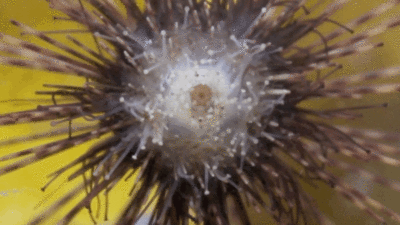
Could you imagine if you had to spend the rest of your life getting all of your nutrients by only eating algae straight off of rocks? That would be crazy! Not only would our teeth wear down into nothingness, it would definitely not be the tastiest meal. So how have our awesome urchin friends been able to do just that? It’s all thanks to their amazing Aristotle’s lantern.
 Sea urchins posses an intricate muscular system located on the underside of their bodies that allow them to scrape food off of almost any ocean surface. Attached to this muscular system are five teeth-like structures made of calcium. These five teeth can be moved in various directions giving urchins both a powerful bite and tons of maneuverability while feeding. This especially comes in handy for urchins trying to feed on all sorts of delicious algae growing within the nooks and crannies of Catalina’s rocky kelp habitat.
Sea urchins posses an intricate muscular system located on the underside of their bodies that allow them to scrape food off of almost any ocean surface. Attached to this muscular system are five teeth-like structures made of calcium. These five teeth can be moved in various directions giving urchins both a powerful bite and tons of maneuverability while feeding. This especially comes in handy for urchins trying to feed on all sorts of delicious algae growing within the nooks and crannies of Catalina’s rocky kelp habitat.
But how did such an intricate system end up with the name Aristotle’s Lantern?
Back in the day when Aristotle, a prominent philosopher and naturalist from the 4th century, roamed the land he noticed an interesting resemblance between horn lanterns and sea urchins. Horn lanterns were a very popular source of illumination at the time. These lanterns were comprised of five panes; each pane thin enough to allow one to see the light from a candle but still strong enough to keep wind from blowing out the flame.
 According to Aristotle, “the mouth-apparatus of the urchin is continuous from one end to the other, but to outward appearance it is not so, but looks like a horn lantern with the panes of horn left out.” Ever since this observation was made the mouth of a sea urchin has been referred to as an Aristotle’s lantern.
According to Aristotle, “the mouth-apparatus of the urchin is continuous from one end to the other, but to outward appearance it is not so, but looks like a horn lantern with the panes of horn left out.” Ever since this observation was made the mouth of a sea urchin has been referred to as an Aristotle’s lantern.
Written by: Alex Feltes


